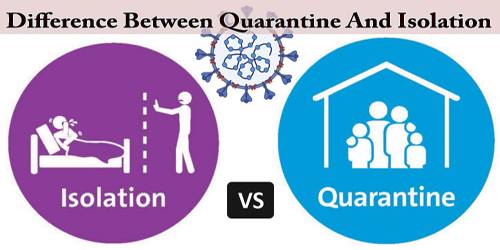In everyday conversations, people sometimes use quarantine and isolation interchangeably to refer to separating people in various ways due to the spread of a disease. But for doctors, public health officials, and other professionals, there is an important distinction between quarantine and isolation.
Quarantine – In general, a quarantine is “a strict isolation imposed to prevent the spread of disease.” Quarantine is used to keep someone who might have been exposed to COVID-19 (coronavirus) away from others. Someone in self-quarantine stays separated from others, and they limit movement outside of their home or current place. A person may have been exposed to the virus without knowing it (for example, when traveling or out in the community), or they could have the virus without feeling symptoms. Quarantine helps limit further spread of COVID-19.
Health experts recommend that self-quarantine lasts 14 days. Two weeks provides enough time for them to know whether or not they will become ill and be contagious to other people.
Self-quarantine involves:
- Using standard hygiene and washing hands frequently
- Not sharing things like towels and utensils
- Staying at home
- Not having visitors
- Staying at least 6 feet (2 meters) away from other people in your household
Entering English in the early 1600s, this “isolation” sense of ‘quarantine’ comes from the Italian quarantina, a period of forty days, derived from quaranta, the Italian for “forty.” (The Italian quaranta, if you’re curious, comes from the Latin quadrāgintā, also meaning “forty.”)
Historically, a quarantine referred to a period originally of 40 days imposed upon ships when suspected of carrying an infectious or contagious disease. This practice was done in Venice in the 1300s in an effort to stave off the plague.
Isolation – Isolation is used to separate sick people from healthy people. People who are in isolation should stay home. In the home, anyone sick should separate themselves from others by staying in a specific “sick” bedroom or space and using a different bathroom (if possible). In medical contexts, isolation specifically means “the complete separation from others of a person suffering from contagious or infectious disease.”
Isolation happens when a person is infected with a communicable disease, and is separated from people who are healthy. This also helps stop the spread of the disease. Voluntary isolation is sometimes called self-isolation, although everyday people using the latter term may not mean they are actually infected.
First recorded around 1825–35, isolation ultimately comes from the same root as insulation: the Latin insulātus, “made into an island,” based on insula, “island.” Isolated is recorded around 1755–65.
Information Sources:
















